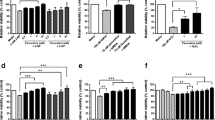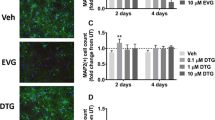Abstract
Currently, there is no effective treatment for neurological complications of infection with the human immunodeficiency virus that persists despite the use of combination antiretroviral therapy. A medium throughput assay was developed for screening neuroprotective compounds using primary mixed neuronal cells and mitochondrial toxin 3-nitropropionic acid. Using this assay, a library of 2,000 compounds was screened. Out of 256 compounds that showed variable degrees of neuroprotection, nine were related to epicatechin, a monomeric flavonoid found in cocoa and green tea leaves that readily crosses the blood–brain barrier. Hence, catechin, epicatechin, and the related compound, epigallocatechin gallate (EGCG) were further screened for their neuroprotective properties against HIV proteins Tat and gp120, and compared to those of resveratrol. Epicatechin and EGCG targets the brain-derived neurotrophic factor (BDNF) and its precursor proBDNF signaling pathways, normalizing both Tat-mediated increases in proapoptotic proBDNF and concomitant Tat-mediated decreases in the mature BDNF protein in hippocampal neurons. Epicatechin and epigallocatechin gallate were more potent than catechin or resveratrol as neuroprotectants. Due to its simpler structure and more efficient blood–brain barrier penetration properties, epicatechin might be the best therapeutic candidate for neurodegenerative diseases including HIV-associated neurocognitive disorders where oxidative stress is an important pathophysiological mechanism.









Similar content being viewed by others
References
Abib RT et al (2010) Genoprotective effects of the green tea-derived polyphenol/epicatechin gallate in C6 astroglial cells. J Med Food 13(5):1111–1115
Dani C et al (2009) Antioxidant activity and phenolic and mineral content of rose grape juice. J Med Food 12(1):188–192
Drouin A et al (2011) Catechin treatment improves cerebrovascular flow-mediated dilation and learning abilities in atherosclerotic mice. Am J Physiol Heart Circ Physiol 300(3):H1032–H1043
Engler MB et al (2004) Flavonoid-rich dark chocolate improves endothelial function and increases plasma epicatechin concentrations in healthy adults. J Am Coll Nutr 23(3):197–204
Faria A et al (2011) Insights into the putative catechin and epicatechin transport across blood–brain barrier. Food Funct 2(1):39–44
Ferruzzi MG et al (2009) Bioavailability of gallic acid and catechins from grape seed polyphenol extract is improved by repeated dosing in rats: implications for treatment in Alzheimer’s disease. J Alzheimers Dis 18(1):113–124
Fraga CG, Oteiza PI (2011) Dietary flavonoids: role of (−)-epicatechin and related procyanidins in cell signaling. Free Radic Biol Med 51(4):813–823
Haughey NJ et al (2004) Perturbation of sphingolipid metabolism and ceramide production in HIV-dementia. Ann Neurol 55(2):257–267
He Y et al (2011) Prolonged exposure of cortical neurons to oligomeric amyloid-beta impairs NMDA receptor function via NADPH oxidase-mediated ROS production: protective effect of green tea (−)-epigallocatechin-3-gallate. ASN Neuro 3(1):e00050
Henning SM et al (2003) Catechin content of 18 teas and a green tea extract supplement correlates with the antioxidant capacity. Nutr Cancer 45(2):226–235
Kang KS et al (2010) Dual beneficial effects of (−)-epigallocatechin-3-gallate on levodopa methylation and hippocampal neurodegeneration: in vitro and in vivo studies. PLoS One 5(8):e11951
Kells AP, Henry RA, Connor B (2008) AAV-BDNF mediated attenuation of quinolinic acid-induced neuropathology and motor function impairment. Gene Ther 15(13):966–977
Kim CY et al (2009) Neuroprotective effect of epigallocatechin-3-gallate against beta-amyloid-induced oxidative and nitrosative cell death via augmentation of antioxidant defense capacity. Arch Pharm Res 32(6):869–881
Kumar P, Kumar A (2009) Protective effects of epigallocatechin gallate following 3-nitropropionic acid-induced brain damage: possible nitric oxide mechanisms. Psychopharmacology (Berl) 207(2):257–270
Leaver KR et al (2009) Oral pre-treatment with epigallocatechin gallate in 6-OHDA lesioned rats produces subtle symptomatic relief but not neuroprotection. Brain Res Bull 80(6):397–402
Lee JS et al (2010) Epicatechin protects the auditory organ by attenuating cisplatin-induced ototoxicity through inhibition of ERK. Toxicol Lett 199(3):308–316
Li W et al (2008) Nitrosative stress with HIV dementia causes decreased L-prostaglandin D synthase activity. Neurology 70(19 Pt 2):1753–1762
Li Q et al (2010) Chronic green tea catechins administration prevents oxidative stress-related brain aging in C57BL/6 J mice. Brain Res 1353:28–35
Lu B, Pang PT, Woo NH (2005) The yin and yang of neurotrophin action. Nat Rev Neurosci 6(8):603–614
Ma M, Nath A (1997) Molecular determinants for cellular uptake of Tat protein of human immunodeficiency virus type 1 in brain cells. J Virol 71(3):2495–2499
Magnuson DS et al (1995) Human immunodeficiency virus type 1 tat activates non-N-methyl-d-aspartate excitatory amino acid receptors and causes neurotoxicity. Ann Neurol 37(3):373–380
Mandel SA et al (2008) Simultaneous manipulation of multiple brain targets by green tea catechins: a potential neuroprotective strategy for Alzheimer and Parkinson diseases. CNS Neurosci Ther 14(4):352–365
Mattson MP, Haughey NJ, Nath A (2005) Cell death in HIV dementia. Cell Death Differ 12(Suppl 1):893–904
McArthur JC et al (2010) Human immunodeficiency virus-associated neurocognitive disorders: mind the gap. Ann Neurol 67(6):699–714
Meeker RB et al (2011) Protein changes in CSF of HIV-infected patients: evidence for loss of neuroprotection. J Neurovirol 17(3):258–273
Moldzio R et al (2010) Effects of epigallocatechin gallate on rotenone-injured murine brain cultures. J Neural Transm 117(1):5–12
Mosmann T (1983) Rapid colorimetric assay for cellular growth and survival: application to proliferation and cytotoxicity assays. J Immunol Methods 65(1–2):55–63
Nath A et al (1996) Identification of a human immunodeficiency virus type 1 Tat epitope that is neuroexcitatory and neurotoxic. J Virol 70(3):1475–1480
Nosheny RL et al (2004) Human immunodeficiency virus type 1 glycoprotein gp120 reduces the levels of brain-derived neurotrophic factor in vivo: potential implication for neuronal cell death. Eur J Neurosci 20(11):2857–2864
Park JW et al (2009) Green tea polyphenol (−)-epigallocatechin gallate reduces neuronal cell damage and up-regulation of MMP-9 activity in hippocampal CA1 and CA2 areas following transient global cerebral ischemia. J Neurosci Res 87(2):567–575
Richard T et al (2011) Neuroprotective properties of resveratrol and derivatives. Ann N Y Acad Sci 1215:103–108
Rothman SM, Griffioen KJ, Wan R, Mattson MP (2012) Brain-derived neurotrophic factor as a regulator of systemic and brain energy metabolism and cardiovascular health. Ann N Y Acad Sci. doi:10.1111/j.1749-6632.2012.06525.x
Schifitto G et al (2009) Selegiline and oxidative stress in HIV-associated cognitive impairment. Neurology 73(23):1975–1981
Teng HK et al (2005) ProBDNF induces neuronal apoptosis via activation of a receptor complex of p75NTR and sortilin. J Neurosci 25(22):5455–5463
Turchan J et al (2001) Estrogen protects against the synergistic toxicity by HIV proteins, methamphetamine and cocaine. BMC Neurosci 2:3
Turchan J et al (2003) Oxidative stress in HIV demented patients and protection ex vivo with novel antioxidants. Neurology 60(2):307–314
Wei IH et al (2011) (−)-Epigallocatechin gallate attenuates NADPH-d/nNOS expression in motor neurons of rats following peripheral nerve injury. BMC Neurosci 12:52
Weinreb O et al (2009) Neuroprotective molecular mechanisms of (−)-epigallocatechin-3-gallate: a reflective outcome of its antioxidant, iron chelating and neuritogenic properties. Genes Nutr 4:283–296
Yin ST et al (2009) Epigallocatechin-3-gallate induced primary cultures of rat hippocampal neurons death linked to calcium overload and oxidative stress. Naunyn Schmiedebergs Arch Pharmacol 379(6):551–564
Yoo KY et al (2010) (−)-Epigallocatechin-3-gallate increases cell proliferation and neuroblasts in the subgranular zone of the dentate gyrus in adult mice. Phytother Res 24(7):1065–1070
Acknowledgments
We thank Tanya Malpica-Llanos for technical assistance, Norman Haughey for providing rat neuronal cultures, and Avindra Nath at the National Institute of Neurological Diseases and Stroke, National Institutes of Health for carefully reading the manuscript and for helpful discussion/comments.
Author information
Authors and Affiliations
Corresponding author
Rights and permissions
About this article
Cite this article
Nath, S., Bachani, M., Harshavardhana, D. et al. Catechins protect neurons against mitochondrial toxins and HIV proteins via activation of the BDNF pathway. J. Neurovirol. 18, 445–455 (2012). https://doi.org/10.1007/s13365-012-0122-1
Received:
Revised:
Accepted:
Published:
Issue Date:
DOI: https://doi.org/10.1007/s13365-012-0122-1




